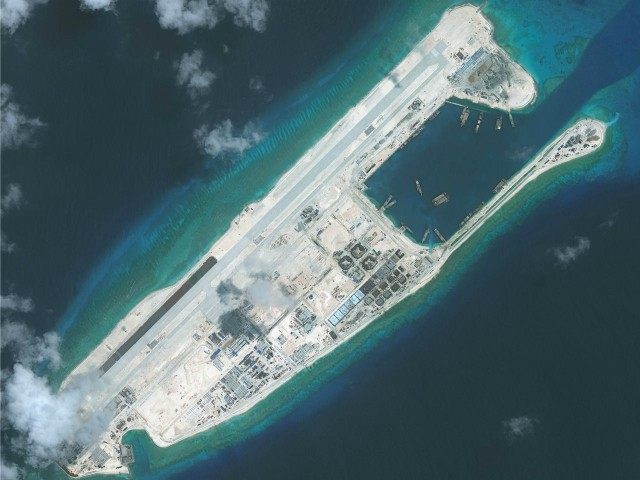A new think tank report asserts that China has begun building a high-frequency radar installation in the contested Spratly Islands of the South China Sea, which would greatly expand its surveillance capabilities in one of the most trafficked trade routes in the world.
The Center for Strategic and International Studies (CSIS) has found evidence that the Chinese government has begun constructing the radar system on Cuateron Reef in the Spratlys, one of many locations where China has constructed artificial land on reefs that are widely considered to be in international waters. Gregory Polling, head of the Asian Maritime Transparency Initiative at CSIS, tells the Washington Post that such a radar system would significantly diminish America’s capacity to navigate freely in the area without being closely monitored by Beijing. “This would be very important in a Chinese anti-access area denial strategy that sought to reduce the ability of the U.S. to operate freely in the South China Sea, including bringing forces up through the South China Sea in case of any future crisis in Northeast Asia,” he told the newspaper via email.
The report goes on to indicate that, in addition to what appears to be a high-frequency radar system being built on Cuateron, other radar locations appear to be scattered across the Spratlys. The New York Times notes CSIS says some of these locations appear to have “possible gun emplacements,” making them a threat to passing aircraft.
The CSIS report appears a week after satellite images published by Fox News showed that China had installed a powerful surface-to-air missile system on an island in the Paracel Island chain, a separate but equally disputed part of the South China Sea. The Philippines contests China’s claimed sovereignty over the Spratly Islands, while Vietnam contests China’s presence in the Paracels. In addition to the missiles, the images showed the construction of a new helicopter base in the region.
Despite the evidence, the Chinese government insists it is not developing military capacities in either island chain. Foreign Minister Wang Yi, currently in the United States to meet with Secretary of State John Kerry, has insisted that the facilities on these islands are for civilian purposes only. When challenged on this claim, the Chinese Foreign Ministry has insisted that “China’s deployment of limited, necessary defense facilities on its own territory is its exercise of its right of self-defense to which a sovereign state is entitled under international law,” as spokeswoman Hua Chunying argued.
The Chinese Foreign Ministry has released a statement on the CSIS report, condemning the organization for targeting Chinese construction in the region, despite the fact that no other country is engaging in such development in the South China Sea. “Someone turned a blind eye to the U.S. behavior, but criticized China’s legitimate islands construction over and over again. It is deliberately stirring up trouble with ulterior motives and exaggerating the tension,” Chinese state outlet Xinhua quotes the Foreign Ministry as saying.
It is not yet certain whether Foreign Minister Wang will discuss the South China Sea dispute with Kerry. In a statement on his trip to Washington on Monday, the Foreign Ministry confirmed that the two leaders would discuss a proper response to increasingly belligerent activity by the rogue government of North Korea. In response to a question on the South China Sea, a ministry spokesperson responded with assertions of Chinese sovereignty in the region but did not note whether Wang would discuss the topic with Kerry during his visit.
In addition to the Philippines and Vietnam, Taiwan, Brunei, and Malaysia all have claims in areas of the South China Sea claimed by Beijing. Indonesia, which does not have territory in that region but does possess islands nearby, has threatened to bring China to the International Court of Justice if its expands its claims. The Philippines has filed a case at the Permanent Court of Arbitration at The Hague.

COMMENTS
Please let us know if you're having issues with commenting.